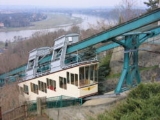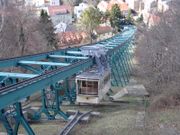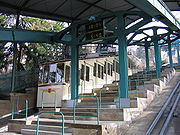
Schwebebahn Dresden
Encyclopedia


Monorail
A monorail is a rail-based transportation system based on a single rail, which acts as its sole support and its guideway. The term is also used variously to describe the beam of the system, or the vehicles traveling on such a beam or track...
— in the world, having opened in 1901. It is situated in Dresden
Dresden
Dresden is the capital city of the Free State of Saxony in Germany. It is situated in a valley on the River Elbe, near the Czech border. The Dresden conurbation is part of the Saxon Triangle metropolitan area....
, Germany
Germany
Germany , officially the Federal Republic of Germany , is a federal parliamentary republic in Europe. The country consists of 16 states while the capital and largest city is Berlin. Germany covers an area of 357,021 km2 and has a largely temperate seasonal climate...
, and connects the districts of Loschwitz
Loschwitz
Loschwitz is a borough of Dresden, Germany, incorporated in 1921. It consists of ten quarters :Loschwitz is a villa quarter located at the slopes north of the Elbe river...
and Oberloschwitz (Rochwitz side). The line is 274 metres long and is supported on 33 pillars. It was designed by Eugen Langen
Eugen Langen
Eugen Langen was a German entrepreneur, engineer and inventor, involved in the development of the petrol engine and the Wuppertal monorail. In 1857 he worked in his father's sugar factory, JJ Langen & Söhne, after an extensive technical training at the Polytechnic institute in Karlsruhe.-Otto and...
, who earlier designed the Schwebebahn Wuppertal, a more extensive suspension railway in Wuppertal
Wuppertal
Wuppertal is a city in North Rhine-Westphalia, Germany. It is located in and around the Wupper river valley, and is situated east of the city of Düsseldorf and south of the Ruhr area. With a population of approximately 350,000, it is the largest city in the Bergisches Land...
.
Despite its unusual suspended format, the Dresden Schwebebahn is operated as a conventional funicular railway
Funicular
A funicular, also known as an inclined plane or cliff railway, is a cable railway in which a cable attached to a pair of tram-like vehicles on rails moves them up and down a steep slope; the ascending and descending vehicles counterbalance each other.-Operation:The basic principle of funicular...
. The two cars are attached to each other by a cable, which runs around a drum at the top of the incline. The ascending car is pulled up the hill by the weight of the descending car, assisted if necessary by an electric drive to the drum.
The line has the following technical parameters:
- Length: 273 metres
- Height: 84 metres
- Maximum Steepness: 39.2%
- Cars: 2
- Capacity: 40 passengers per car
- Configuration: Double suspension track
- Maximum speed: 2.5 metres per second
- Traction: Electricity
The Schwebebahn was not damaged in World War II
World War II
World War II, or the Second World War , was a global conflict lasting from 1939 to 1945, involving most of the world's nations—including all of the great powers—eventually forming two opposing military alliances: the Allies and the Axis...
, but it was out of service from 1984 to 1992 because of reconstruction. After 1990, and in 2002, extensive repair works took place and there is now a new lookout point on the roof of the station.
The Schwebebahn is one of two funicular railways in Dresden, the other being the much more conventional Standseilbahn Dresden
Standseilbahn Dresden
The Dresden Funicular Railway is a funicular in Dresden, Germany connecting the districts of Loschwitz, near the "Blue Wonder" bridge, and Weisser Hirsch...
. Both lines are operated by the Dresdner Verkehrsbetriebe AG, who also operate the city's tram
Tram
A tram is a passenger rail vehicle which runs on tracks along public urban streets and also sometimes on separate rights of way. It may also run between cities and/or towns , and/or partially grade separated even in the cities...
, bus
Bus
A bus is a road vehicle designed to carry passengers. Buses can have a capacity as high as 300 passengers. The most common type of bus is the single-decker bus, with larger loads carried by double-decker buses and articulated buses, and smaller loads carried by midibuses and minibuses; coaches are...
and ferry
Ferry
A ferry is a form of transportation, usually a boat, but sometimes a ship, used to carry primarily passengers, and sometimes vehicles and cargo as well, across a body of water. Most ferries operate on regular, frequent, return services...
networks.

